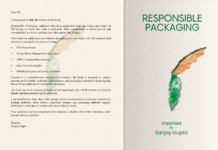On 11 November 2020, Billerudkorsnäs organized a webinar providing a quick and understandable overview of the ISO 11607 standard. After introducing ISO 11607, Radhika Peterson, regulatory affairs manager, and Jonathan Andrews, business development director Medical at Billerudkorsnäs, presented an overview of the company and case studies explaining the significance of standards compliance.
Medical paper by Billerudkorsnäs
Sweden headquartered Billerudkorsnäs, with a turnover of SEK 24.4 billion (approximately Rs 21,000 crore), owns eight paper mills – six in Sweden, and one each in Finland and the UK. The company is highly rated by the Dow Jones Sustainability Indices.
BillerudKosnas manufactures medical papers at two mills – Beetham (UK) and Skärblacka (Sweden). As Andrews explained, “The company has multiple production sites for medical papers and a very broad range of medical packaging papers. It has decades of experience and deep knowledge of the market requirement. . . The two mills independently developed medical packaging papers many years ago before coming together in 2004. Their legacy product ranges combine to form a truly extensive catalog.”
The Beetham mill began producing medical paper in the late 1960s, specializing in the UK ministry of defense requirements. Today, 50 years later, it is the home of Billerudkorsnäs steam sterilizable grades, advanced direct seal, and reinforced papers.
Billerudkorsnäs’ Skärblacka mill has produced papers for medical device packaging since the 1980s. It makes cost-effective direct seal papers for thermoform-fill and seal applications and lightweight, clean papers for applications such as surgeon’s gloves inner wraps.
Standards – Why we need them
Peterson believes that there are many good reasons to use standards – “We may not be aware of them, but we use standards every day. A standard is a great way of making a product, managing the process, or even delivering service. Standards help us ensure safety and lead to a better quality of product and service and thus happier customers. Often, we all recognize standards as testing methods because standards contain requirements and recommendations.”
Mandatory vs Voluntary
According to Peterson, regulations and directives are mandatory for businesses. However, it is not obligatory to comply with standards. Standards remain voluntary. She added, “A standard is an excellent tool to show compliance with an appropriate part of a directive. You can use the same testing procedure as your customer, ensure safety and reliability, ensure production quality, and use common nomenclature.” Peterson explained the relevant types of standards as:
- Harmonized standards for the presumption of conformity with regulation or directive, for example, ISO 13485 and ISO 10993
- Standards are referred to as horizontal and vertical standards based on their applications. For example, ISO 11607 is a horizontal standard applicable for all types of materials, packaging, and related medical devices. Vertical standards, on the contrary, apply to a particular area, industry, or process – for example, EN 868 is related to specific materials used for medical packaging.
- Test methods describe the testing methodology, what to test, how to test, and how to report the results, for example, ASTM, DIN, EN, ISO, and Tappi. The technical specification does not have the same high dignity, such as ISO/TS 16775.
“Standards are also referred to as horizontal and vertical in their applications. It is very important always to have the latest version as the revision can differ significantly,” she added.
Standards used for medical packaging
After a brief introduction about the standards used for medical packaging, Peterson presented two case studies where the lack of compliance led to consequences. “In one case, the packaging caused an infection problem in the hospital. The investigation showed that no integrity test was done during validation. If the standardized integrity test ASTM 1929 blue dye had been used, production quality could have been ensured. Therefore, it is important to use a test according to the scope of the method.”
The second case emphasized the need to consider all essential factors such as sterilization, the packaging line, and others. “If both parts of ISO 11607 had been considered in the design process, the validation would be finalized.”
Why use ISO 11607?
It is recommended to use the standard as a ready tool for compliance requirements. There are plenty of reasons to use ISO 11607 – to ensure the integrity of the packaging, rationale behind each acceptance criteria, and considering the worst-case scenario to develop technical files and protocols. The standard considers all aspects of the packaging design, such as material properties, converting files, sterilization – the whole packaging system.
Formal approval of the process validation is needed. Peterson added, “The documentation shall summarize and reference all protocols, resource and state conclusions regarding the validation status of the process. It should include procedures to ensure that the packaging production process is under control and within the established parameters during routine operation.
“The sterile barrier system shall be assembled under appropriate conditions to minimize the risk of contamination. Specified process variables shall be routinely monitored and documented.”
Key takeaways
Concluding the webinar, Andrews reiterated the key takeaways of the webinar, saying, “Medical packaging is almost as important as the device itself. You should contact your material supplier for the supporting data. Standards are our friends, not enemies. They make your life easier when testing, evaluating, and validating. However, it is important to keep track of the latest reversion or revision of the standard to avoid problems.”












